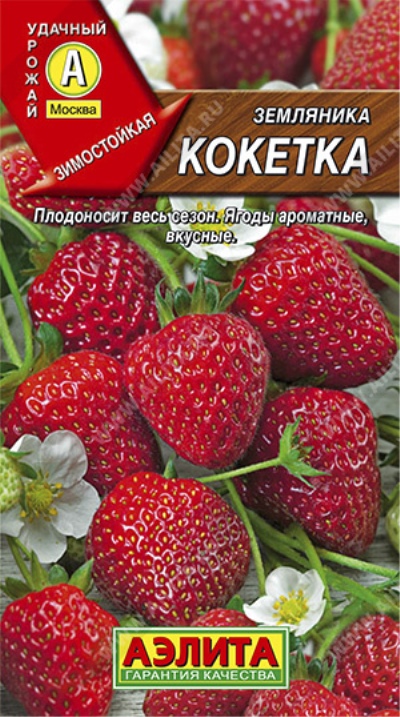
- Taste: sweet
- The size: large
- Weight: 20-30 gr
- Yield rate: high
- Repairability: Yes
- Ripening terms: early
- Appointment: universal
- Description of the bush: strong, compact
- Berry color: red or scarlet
- Winter hardiness: winter hardy
Strawberry Koketka belongs to modern remontant varieties. It has established itself well among gardeners due to its long fruiting period, excellent taste and good resistance to various diseases.
Description of the variety
The Koketka variety is characterized by strong semi-spreading, but compact bushes about 20 cm tall. The leaf plates are green, medium-sized, shiny. They are concave, slightly wrinkled, with obtuse wide teeth along the edges. Peduncles are long, located below the leaves, formed several times per season.
Flowers are white, bisexual, untwisted. The stalks of the strawberry Coquette are thick and long. Like many modern remontant varieties, the mustache is not formed in this variety.
Ripening terms
Koketka berries ripen early. Fruiting due to remontant qualities occurs from June to September. Thus, under favorable weather conditions, the berries ripen 4 times per season.
Yield
Strawberries of the Koketka variety are characterized by a high yield. These indicators are 1.6-2 kg / m2 and 163 kg / ha. Harvesting is easy, as the bushes are very compact.
Berries and their taste
Fruits of the Koketka variety of red or scarlet color shine and have a neck. The berries are elongated-oval in shape. They are quite large: the mass of one berry is 20-30 g. The pulp is characterized by juiciness and tenderness. The taste of Koketka strawberries is sweet, but with sourness, and the aroma resembles the smell of wild strawberries.
The berries of this variety have a universal purpose. They are good both fresh and in various preparations (preserves, jams). Strawberry Koketka can be successfully transported, it retains its taste and presentation for a long time.
Growing features
The Koketka strawberry variety is not very difficult to grow and is suitable even for novice gardeners. Watering should be done in moderation, since this variety is characterized by moderate drought resistance. The culture is winter-hardy, but in a climate with little snow it requires shelter for the winter. Strawberry Coquette has a very good immunity to various diseases that plants of this species usually suffer from. Care consists mainly in the timely removal of weeds and loosening of the soil.




Site selection and soil preparation
For Koketka strawberries, it is recommended to choose a sunny area with loose and fertile soil. A slightly acidic and neutral soil reaction will be preferred. It is better to fertilize the soil with compost and humus in the autumn, digging up the soil. Young bushes are usually planted in May. When planting, a distance of 25-30 cm between bushes and 15-20 cm between rows should be observed, since strawberries of this variety do not grow in width.

Pollination
The Koketka variety is characterized by bisexual flowers. This means that self-pollination is inherent in these plants. For successful fruit setting, no additional pollination measures are required.

One of the important techniques in strawberry care is feeding. Regular fertilization guarantees a rich harvest. There are several different ways to feed strawberries, and each of them is designed for a specific period of plant development. During flowering, fruiting and after it, feeding should be different.

Diseases and pests
The coquette is resistant to various diseases affecting this plant species. Even young bushes have good immunity. However, the cultivar can be affected by the strawberry mite.
These pests severely damage the leaves of the strawberry, as a result of which the plant weakens and ceases to bear fruit. For prevention purposes, it is necessary to spray the bushes with 3% Bordeaux liquid during the growing season. You can also use acaricides: colloidal sulfur or preparations "Tiovit Jet", "Actellik", "Fufanon-Nova". When buying strawberries, be sure to pay attention to the leaves: they should not be curled and wrinkled.

Strawberries are often subject to many dangerous diseases that can seriously undermine its condition. Among the most common are powdery mildew, gray mold, brown spot, anthracnose, and verticillosis. Before buying a variety, you need to inquire about its disease resistance.
Reproduction
Strawberries of this variety are bred, as a rule, with the help of seeds, since it does not form a mustache, and it is not recommended to propagate remontant plants by dividing the bush.
Sowing seeds should be done in March-April in soil consisting of humus, sand and peat. You can buy ready-made land in the store. The seed is sown superficially, without embedding it in the soil. After that, the container is covered with glass until shoots appear, periodically moistening the ground from a spray bottle. When the plants have 2 real leaves, they can be dived into separate pots.Young strawberry bushes Koketka are planted in open ground when 5-6 true leaves grow on them.



















































































